REAR SEATS : long chassis version

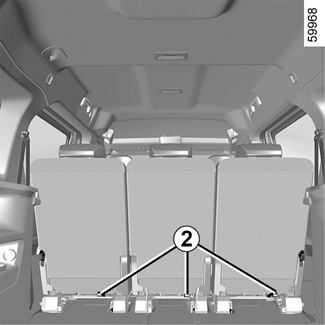
Second row rear seats
The rear seats are separate seats.
To move the seats forwards or backwards
Lift the lever 1 or, from the rear of the seat, pull the black strap 2 to unlock the seat.
Once in the desired position, release the lever 1 or handle 2 and check that the seat is correctly locked to the floor.
For safety reasons, carry out any adjustments while the vehicle is stationary.
When moving the rear seats, ensure that nothing obstructs the anchorage points (passenger's arm or leg, a pet, gravel, cloth, toys, etc.).
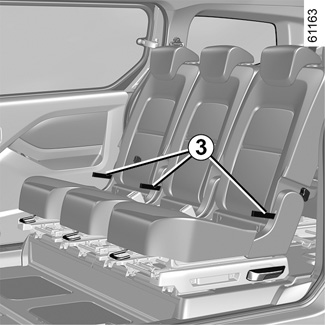
To tilt the seatback
(comfort position)
Pull the strap 3 to unlock the seatback and tilt it to the desired position (three possible positions).
Release the strap once the seat is in the correct position 3 and ensure that the seatback is fully locked into position.

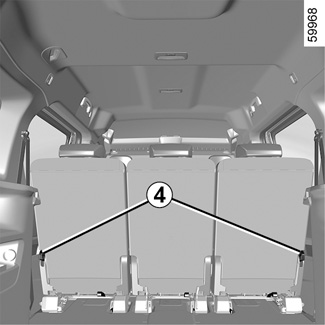
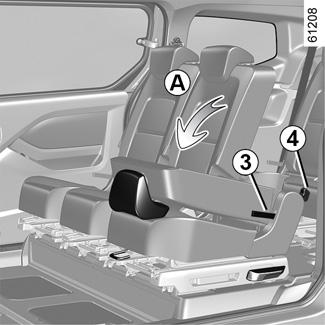
To fold down a seatback (table position)
- Lower the headrest as far as it will go;
- pull the strap 3 or, from the rear of the side seat, push the handle 4 to unlock the seatback;
- fold down the seatback and release the strap 3 or the handle 4;
- make sure you lock the seat back in place.
A table position can be created by folding the seatback (movement A) all the way down onto the seat base.
The seats can hold up to 80 kg in this position.
To avoid all risk of injury, ensure that nobody is in the proximity of the moving parts.
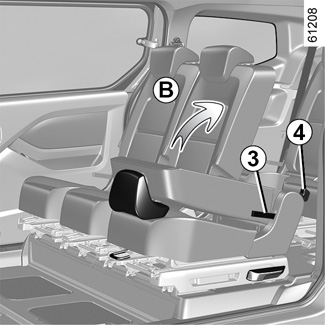
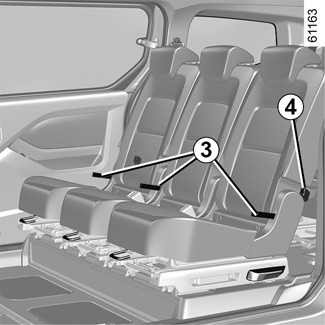
To raise the seatback
(table position)
- Pull the strap 3 or push the handle 4 to unlock the seatback;
- grab the seatback and raise it (movement B);
- check that it is correctly locked in place.
For safety reasons, carry out any adjustments while the vehicle is stationary.
To avoid all risk of injury, ensure that nobody is in the proximity of the moving parts.
When refitting the seatback, make sure it is correctly locked in place.
If seat covers are fitted, make sure these do not prevent the seatback latch from locking in.
Make sure that the seat belts are positioned correctly.
Reposition the headrests.

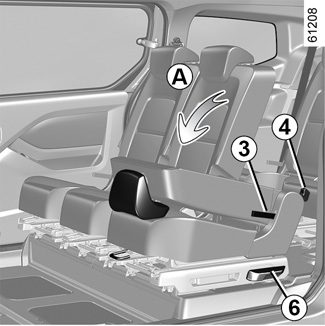
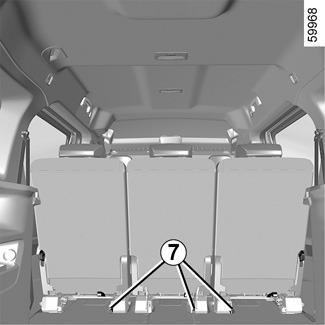

Folding up a seat
(folded position)
- Bring the front seats forward;
- make sure that no devices are connected to the accessories socket 5;
- lower the headrest as far as it will go;
- move the seat as far back as possible towards the rear of the vehicle;
- fold down the seatback in the table position (movement A) by pulling on the strap 3 or by pushing the handle 4;
- lift the handle 6 as far as it will go to unlock the seat, or pull the red strap 7 from the rear of the seat if you are sitting in a third-row seat;
- lift and guide the seat until it is vertical (movement C) in the folded position.
To avoid all risk of injury, ensure that nobody is in the proximity of the moving parts.
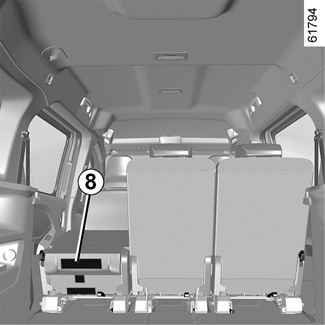
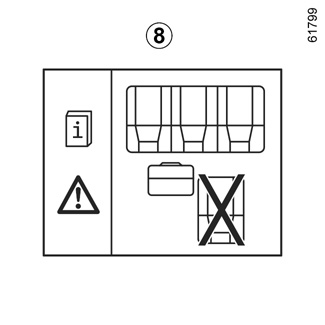
Restriction of use
It is not permitted to drive with a seat folded down if a passenger is in another seat in the same row.
The label 8 located on the back of the seats reminds you of this.
Risk of injury.
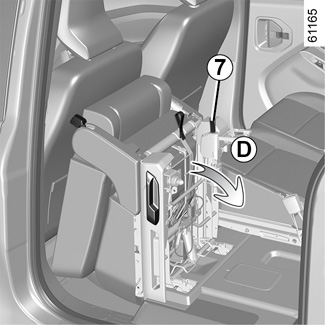
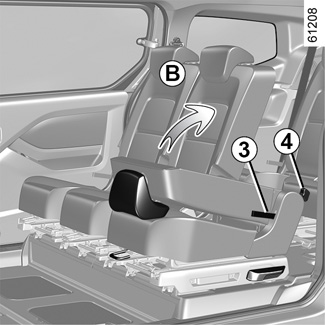
To reposition the seat
- Pull up the red strap 7 as far as it will go and lower the seat until it locks onto the floor (movement D);
- Make sure the seat is locked securely to the floor;
- Lift the seatback (movement B) by pulling the strap 3 or by pushing the handle 4.
For safety reasons, carry out any adjustments when the vehicle is not being driven.
When refitting the seatback, make sure it is correctly locked in place.
If seat covers are fitted, make sure that these do not prevent the seatback from locking.
Make sure that the seat belts are positioned correctly.
Reposition the headrests.
To avoid all risk of injury, ensure that nobody is in the proximity of the moving parts.
When moving the rear seats, ensure that nothing obstructs the anchorage points (passenger's arm or leg, a pet, gravel, cloth, toys, etc.).
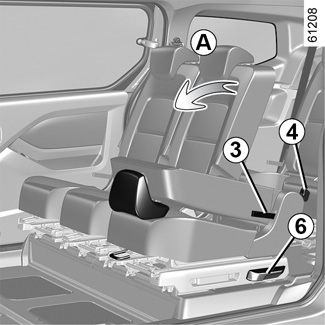
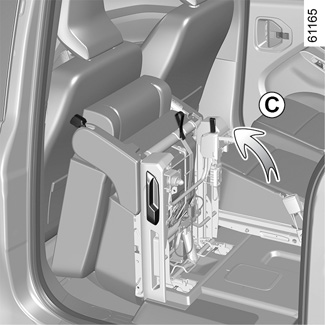
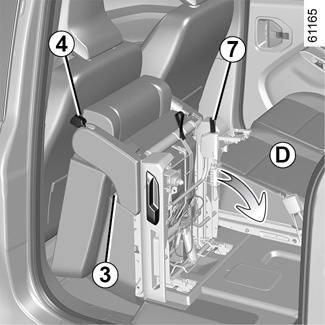
Third row rear seats
Accessing the third-row rear seats
- Move the second-row rear seat as far back as possible;
- Lower the seat headrest as far as it will go;
- Fold down the seatback (movement A);
- Lift the handle 6 as far as it will go to unlock the seat;
- Lift and guide the seat to the vertical position (movement C);
- Sit in the third-row rear seat.
To return the second-row seat to its original position:
- Pull the red strap 7 as far as it will go to return the seat to the table position (movement D);
- Make sure that the seat is locked securely to the floor;
- Lift the seatback by pulling on the strap 3 or by pushing the handle 4.
When handling the seats, please guide them through the full movement.
When moving the rear seats, ensure that nothing obstructs the anchorage points (passenger's arm or leg, a pet, gravel, cloth, toys, etc.).
Before moving a second-row seat forwards, ensure that the seat is in the table position.
The label 9 located on the back of the seats reminds you of this.

Restriction of use
To avoid all risk of injury, ensure that nobody is in the proximity of the moving parts.
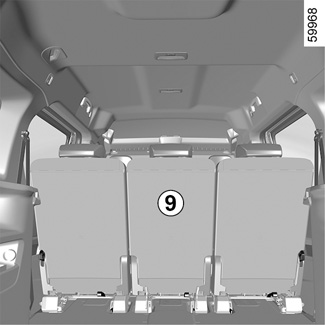
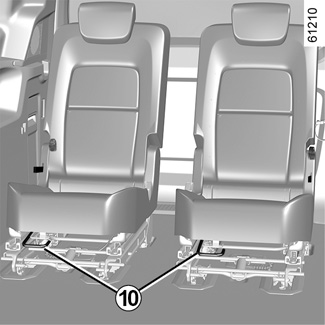
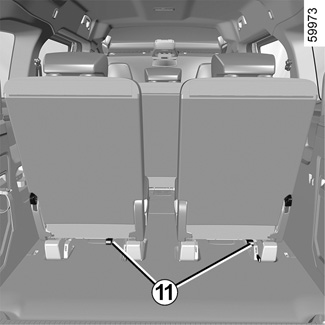
To move the seats forwards or backwards
Lift the lever 10 or, from the rear of the seat, pull the black strap 11 to unlock the seat.
Once in the desired position, release the lever 10 or black handle 11 and check that the seat is correctly locked to the floor.
When moving third row rear seats:
- Check that nobody is near any of the moving parts;
- Check that there is sufficient space around the seat;
- Check that nothing is obstructing the section of the boot reserved for storing the seat.
For safety reasons, carry out any adjustments when the vehicle is stationary.
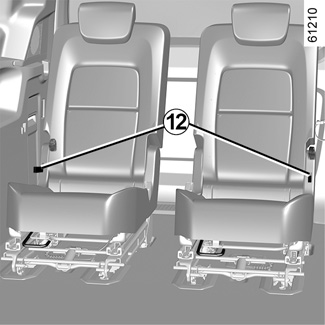

To tilt the seatback
(comfort position)
Pull the strap 12 to unlock the seatback and tilt it to the desired position (three possible positions).
Release the strap once the seat is in the correct position 12 and ensure that the seatback is fully locked into position.
To fold down a seatback (table position)
- Lower the headrest as far as it will go;
- Pull the strap 12 or, from the rear of the seat, push the handle 13 to unlock the seatback;
- Fold down the seatback and release the strap 12 or the handle 13;
- Make sure you lock the seat back in place.
Make sure that the seatback is correctly locked. If necessary, remove any obstacles behind the seats. Repeat the procedure until the seat is correctly locked.

A table position can be created by folding the seatback (movement E) all the way down onto the seat base.
The seats can hold up to 80 kg in this position.
To avoid all risk of injury, ensure that nobody is in the proximity of the moving parts.
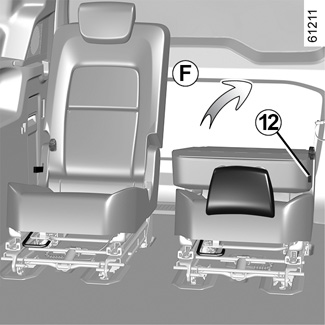
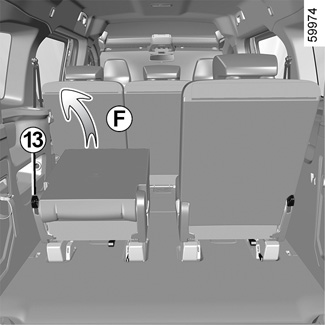
To raise the seatback
(table position)
- Pull the strap 12 or push the handle 13 to unlock the seatback;
- Grab the seatback and raise it (movement F);
- Check that it is correctly locked in place.
For safety reasons, carry out any adjustments while the vehicle is stationary.
To avoid all risk of injury, ensure that nobody is in the proximity of the moving parts.
When refitting the seatback, make sure it is correctly locked in place.
If seat covers are fitted, make sure these do not prevent the seatback latch from locking in.
Make sure that the seat belts are positioned correctly.
Reposition the headrests.
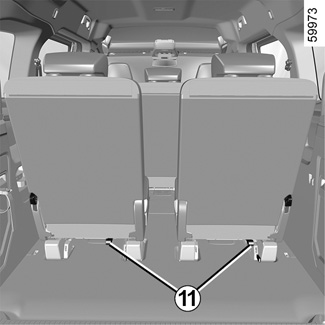

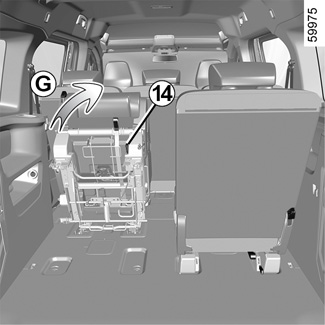
Folding up a seat
(folded position)
- Push the second-row seats fully forward;
- Lower the headrest as far as it will go;
- Move the seat as far back as possible towards the rear of the vehicle using the black strap 11;
- Fold down the back of the seat in the table position (movement E) using the handle 13;
- Pull the red strap 14 from the rear of the seat to unlock it;
- Lift and guide the seat until it is vertical (movement G) in the folded position.
When moving the rear seats, ensure that nothing obstructs the anchorage points (passenger's arm or leg, a pet, gravel, cloth, toys, etc.).
When moving third row rear seats:
- Check that nobody is near any of the moving parts;
- Check that there is sufficient space around the seat;
- Check that nothing is obstructing the section of the boot reserved for storing the seat.
For safety reasons, carry out any adjustments when the vehicle is stationary.


To reposition the seat
- Pull the red strap 14 as far as it will go and lower the seat (movement H) until it locks onto the floor;
- Make sure the seat is correctly locked in position;
- Lift the seatback (movement F) by pushing the handle 13.
No person or animal should be on the third row rear seats if the luggage compartment cover is not removed.
When moving the rear seats, ensure that nothing obstructs the anchorage points (passenger’s arm or leg, a pet, gravel, cloth, toys, etc.).
When moving third row rear seats:
- Check that nobody is near any of the moving parts;
- Check that there is sufficient space around the seat;
- Check that nothing is obstructing the section of the boot reserved for storing the seat.
For safety reasons, carry out any adjustments when the vehicle is stationary.
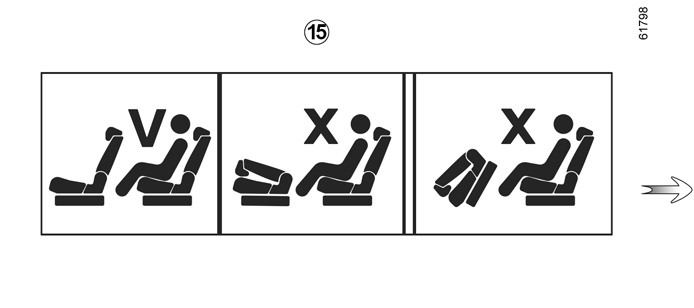
Restriction of use
It is not permitted to drive with one of the seat backs or a second row seat folded down if a passenger is in one of the third row seats.
The label 15 located on the back of the seats reminds you of this.
Risk of injury.

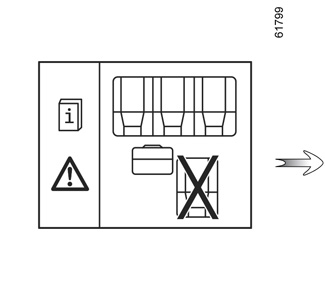
Restriction of use
It is not permitted to drive with a seat folded down if a passenger is in another seat in the same row.
The label 16 located on the back of the seats reminds you of this.
Risk of injury.
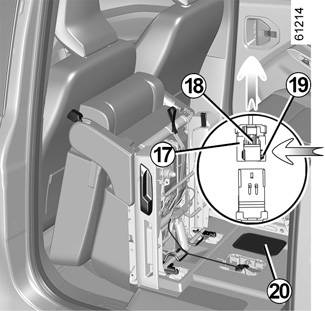


Second-row and third-row rear seats
To remove the seats
The second-row and third-row seats can be removed for transporting bulky objects. They are fitted with a connector to indicate the presence of the seat on the vehicle and/or the presence of a passenger on the seat and its belt SEAT BELTS.
- Fold the seat into the folded position, and remove the flap 20;
- Disconnect the connector 17 by moving the red tab 19;
- Press the area 18 around the connector and pull it at the same time to disconnect it;
- Ensure the disconnect by manipulating the connector without pulling the cable 21;
- Attach the cable 21 from the connector to the clip 22;
- Replace the flap 20.
To remove the seat:
- Pull the release switch 23 indicated with a red marking and hold it to tilt the seat to 45°;
- Guide the seat to the table position.
You can then remove the unlocked seat from the vehicle.
To avoid all risk of injury, ensure that nobody is in the proximity of the moving parts.
For safety reasons, carry out any adjustments when the vehicle is not being driven.
The rear seat is heavy. For your own safety, please handle it carefully.
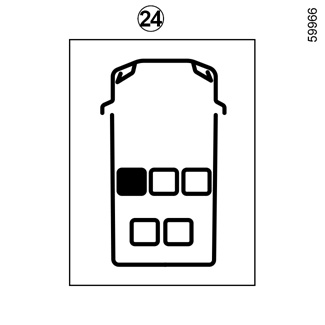
To install seats
Before fitting a seat, check that it is in the correct position in the vehicle.
The information can be found on the label 24 located on the back of the seat.
The seats must not be swapped.
When moving the rear seats, ensure that nothing obstructs the anchorage points (passenger's arm or leg, a pet, gravel, cloth, toys, etc.).
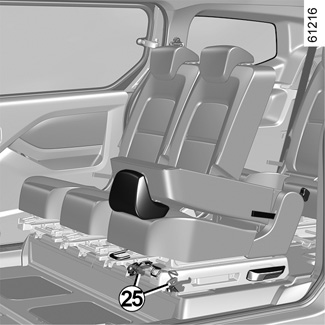
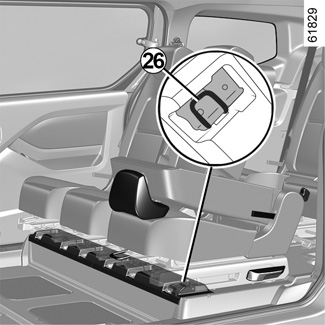
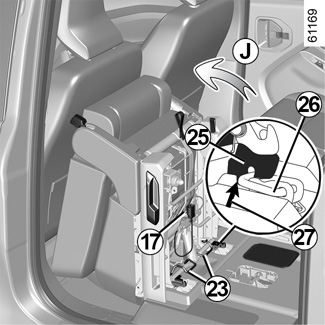
- Attach the hooks 25 to the anchorage point 26 marked with an arrow 27 by gently lifting the back of the seat;
- Move the seat as far forward as possible (movement J);
- The release switch 23 locks, accompanied by a locking noise;
- Reconnect the connector 17.
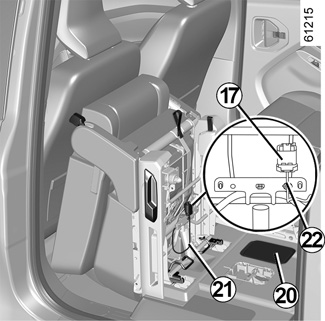
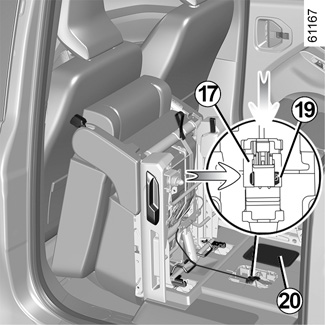
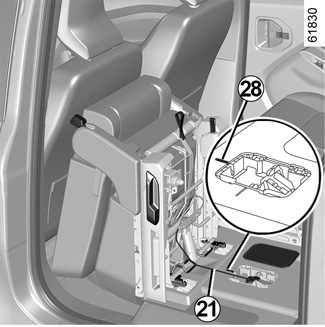
To install seats
(continued)
To connect the connector 17:
- Remove the flap 20;
- Unhook the cable 21 from the connector on the clip 22;
- Plug in the connector 17 and lock the red tab 19;
- Reposition the cable 21 in the carpet recess 28;
- Replace the flap 20.
When refitting a seat in the vehicle, be sure to reconnect the seat connector. If this is not the case, the seat belt buckle information will not be shown on the instrument panel SEAT BELTS.
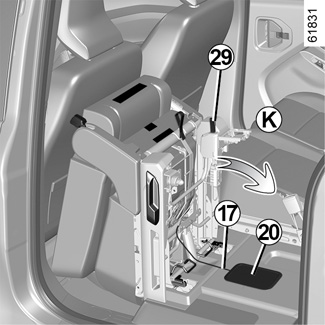
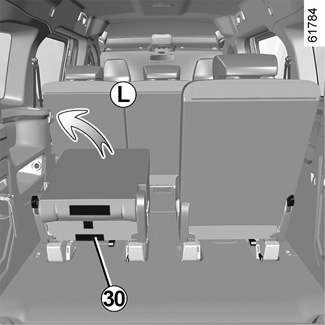
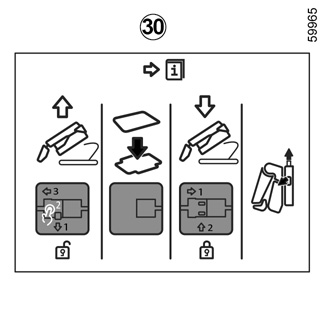
To install seats
(continued)
To place the seats in the position of use:
- Pull the red strap 29 as far as it will go;
- Lower the seat and guide it until it locks onto the floor (movement K).
Make sure the seat is correctly locked in position.
Raise the seatback (movement L).
When moving the rear seats, ensure that nothing obstructs the anchorage points (passenger’s arm or leg, a pet, gravel, cloth, toys, etc.).
After replacing the connector 17 and closing the flap 20, it is essential to pull the red strap 29 before folding down the seat.
The label 30 located on the back of the seats reminds you of this.
To avoid all risk of injury, ensure that nobody is in the proximity of the moving parts.